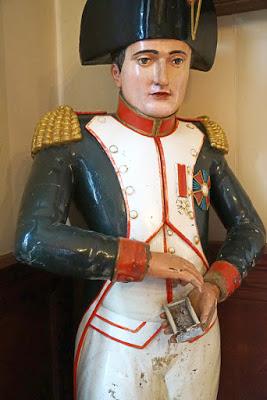
Think of Napoleon, and what other word comes to mind? It might be France, Emperor, or Waterloo - maybe 'short' since the myth of his small stature has proved remarkably persistent - but it probably won't be 'snuff'. Yet that was exactly the association a York tobacconist expected their customers to make.

The wooden statue of Napoleon is now in the Merchant Adventurers' Hall in York, but for a century and a half he stood outside the premises of Mr Clarke in Bridge Street. He had been brought over from France in 1822, along with two other Napoleons who went to Leeds and London; neither are thought to have survived. Apparently, they cost £50 each - equivalent to several thousand pounds today - and he is carved from oak.
York's Napoleon had his own misadventures: during the Second World War, celebrating soldiers threw him in the River Ouse; and once, accidentally left out overnight, he was taken into police custody and had to be retrieved from the cells. In 1973, Napoleon moved to Judith Thorpe's shop in Lendal, York, where he was apparently particularly popular with French visitors. He stayed outside the shop until moving to the Hall in 1997.

But still, why Napoleon? The answer is that he was known for taking snuff. However, if his valet is to be believed, that reputation was somewhat overblown:
although he wasted a great quantity of it, he really used very little, as he took a pinch, held it to his nose simply to smell it, and let it fall immediately. It is true that the place where he had been was covered with it; but his handkerchiefs, irreproachable witnesses in such matters, were scarcely stained, and although they were white and of very fine linen, certainly bore no marks of a snuff-taker. Sometimes he simply passed his open snuff-box under his nose in order to breathe the odor of the tobacco it contained.Nonetheless, it may have had a special resonance in York: one of the Yorkshire regiments, the Green Howards, hold a gold snuffbox given by Napoleon to Marechal Ney. The treasure, with its portrait of the Emperor on its lid, was seized from Ney's coach at Waterloo and became a prize exhibit in the regimental museum. Perhaps that helps explain why York kept its wooden figure long after London.
As for that statue of Napoleon in London, I haven't yet found where it was displayed. If anybody has information about it, please share it in the comments.

